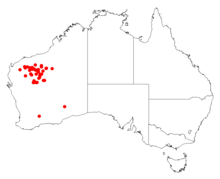Acacia marramamba
Acacia marramamba, commonly known as marramamba,[1] is a shrub or tree belonging to the genus Acacia and the subgenus Phyllodineae that is endemic to arid parts of western Australia.
| Marramamba | |
|---|---|
| Scientific classification | |
| Kingdom: | Plantae |
| Clade: | Tracheophytes |
| Clade: | Angiosperms |
| Clade: | Eudicots |
| Clade: | Rosids |
| Order: | Fabales |
| Family: | Fabaceae |
| Clade: | Mimosoideae |
| Genus: | Acacia |
| Species: | A. marramamba |
| Binomial name | |
| Acacia marramamba | |
 | |
Description
The bushy spinescent shrub or tree typically grows to a height of 1.0 to 3.0 metres (3.3 to 9.8 ft).[2] It has grey coloured bark that is mostly smooth but becomes fissured and fibrous near the base of the tree. It has glabrous red-brown to light brown or orange coloured branchlets with vivid light green new shoots and shiny stipules that are 2 to 4 mm (0.079 to 0.157 in) in length. Like most species of Acacia it has phyllodes rather than true leaves. The asymmetric and evergreen leathery phyllodes are a pale milk green to blue-green colour and have a rounded upper margin and almost straight lower margin with a length of 2 to 5 cm (0.79 to 1.97 in) and a width of 9 to 23 mm (0.35 to 0.91 in). The phyllodes have a main longitudinal nerve and form a needle-sharp point with a length of 1 to 3 mm (0.039 to 0.118 in) at the tip.[1] It produces red and yellow flowers from May to July.[2]
Taxonomy
The species was first formally described by the botanist Bruce Maslin in 1982 as part of the work Studies in the genus Acacia (Leguminosae: Mimosoideae). Acacia species of the Hamersley Range area, Western Australia as published in the journal Nuytsia. It was reclassified as Racosperma marramamba by Leslie Pedley in 2003 then transferred back to genus Acacia in 2006.[3] The specific epithet is derived from the area where it is found in the Pilbara in the Marra Mamba Iron Formation.[1]
Distribution
It is native to an area in the Gascoyne, Pilbara and Goldfields regions of Western Australia where it is often situated on rocky hillslopes growing in gravelly and stony skeletal soils often over or around ironstone.[2] It has a scattered distribution with the bulk of the population in the Pilbara from around Duck Creek Station in the north west to Balfour Downs Station to the north east it is also found in the Barlee Range and upper catchments of the Gascoyne, Ashburton and Murchison Rivers and down to around Mount Fraser in the south. It does not form dense populations it is generally not uncommon throughout its range. It is usually a part of open woodland communities dominated by Eucalyptus leucophloia or tall open shrubland communities where it is associated with Acacia aneura , Acacia sibirica and Acacia maitlandii with a spinifex understorey.[1]
See also
References
- "Acacia marramamba". Wattles of the Pilbara. Department of Environment and Conservation. 2010. Retrieved 7 July 2020.
- "Acacia marramamba". FloraBase. Western Australian Government Department of Parks and Wildlife.
- "Acacia marramamba Maslin". Atlas of Living Australia. Global Biodiversity Information Facility. Retrieved 7 July 2020.